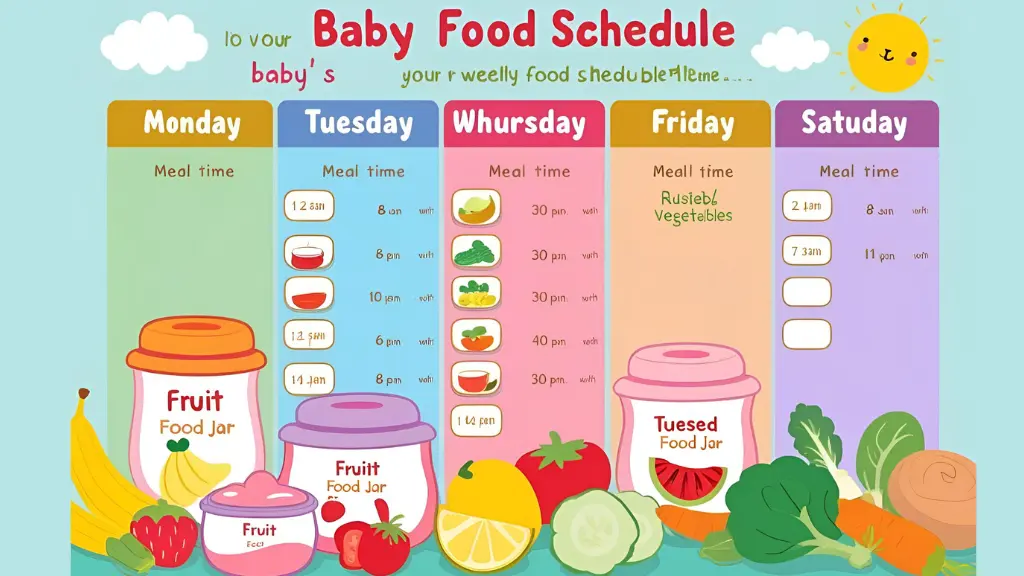When should you start a baby food schedule? The right time is typically around 6 months when your baby is ready to begin solids. Before this, breast milk or formula was all they needed for nutrition. Starting solids too early can pose risks, but waiting too long may delay your baby’s growth and development.
At 6 months, babies can usually sit up, hold their heads steady, and show interest in food. You’ll start with purees and gradually move to more solid foods as they grow.

In this article, we’ll guide you through creating a baby food schedule that supports your little one’s health and development.
When to Start Solid Foods?
Every parent wonders, “When is the right time to start solid foods?” It’s a common question, and the answer is more straightforward than you think. Experts recommend waiting until your baby is about 6 months old before introducing solids.
Why? At this age, babies typically have the physical ability to sit up on their own and hold their heads steady, which makes feeding solids safer and more manageable.
But that’s not the only sign to look out for. Your baby should also show an interest in food and be able to move food to the back of their mouth with their tongue.
If your baby is still breastfeeding or formula-feeding happily, you can hold off on solids a bit longer, but be sure to consult with your pediatrician if you have any doubts.
Baby Food Schedule by Age
The baby food schedule evolves as your baby grows. They go from simple liquids to textured purees to chewing and self-feeding. Here’s a quick breakdown by age:
First Foods for Babies (4-6 Months)
At around 4-6 months, your baby is ready for their first taste of solid food. While breast milk or formula should still be the primary source of nutrition, this is the perfect time to introduce solids.
What to start with:
- Single-grain baby cereal: Rice cereal or oatmeal are great choices.
- Pureed fruits: Think mashed bananas or applesauce.
- Pureed vegetables: Try smooth carrots, sweet potatoes, or peas.
When you start, introduce one new food at a time, waiting a few days to check for any allergic reactions.
Expanding the Menu (6-8 Months)
As your baby becomes comfortable with solids, it’s time to expand their menu. They’ll enjoy a wider variety of textures and flavors at this stage.
What to add:
- Mashed or pureed fruits and vegetables: Avocados, pears, peaches, and zucchini.
- Pureed meats: Chicken, turkey, or beef (cooked thoroughly and pureed).
- Whole-grain cereals: Barley or oatmeal.
You may also start introducing finger foods like soft, cooked vegetables or small pieces of fruit. These are great for babies starting to practice their fine motor skills.
Moving Toward Finger Foods (9-12 Months)
By 9 months, your baby is ready to transition to more solid foods. They can now handle more texture and might even start feeding themselves with their fingers. This is a fun stage as they explore more independent eating.
What to try:
- Small pieces of soft fruits and vegetables: Bananas, cooked carrots, or small pieces of avocado.
- Cheese and yogurt: Soft cheeses like cottage cheese or plain, whole milk yogurt.
- Small pieces of bread or crackers: You can try offering soft bread pieces or whole-grain crackers.
This is also the time to introduce your baby to family meals. Keep the meals simple and cut the food into small, manageable pieces.
Sample Daily Feeding Schedule
Now that you know what foods to introduce and when to put them all together into a sample feeding schedule,
| Time | Feeding Option |
| 7:00 AM | Breast milk/formula |
| 8:00 AM | Breakfast: Oatmeal or pureed fruits |
| 12:00 PM | Breast milk/formula |
| 1:00 PM | Lunch: Pureed veggies or mashed potatoes |
| 4:00 PM | Breast milk/formula |
| 5:00 PM | Dinner: Soft finger foods (like avocado) |
| 7:00 PM | Breast milk/formula |
This schedule is just a guide and will vary based on your baby’s appetite and needs. Some babies may need more or less, so following their cues is essential.
Foods to Avoid in the First Year
While it’s exciting to introduce new foods, it’s equally important to know what foods are not safe for your baby during the first year. Here’s a list of foods to avoid:
- Honey: Never give honey to babies under 1 year old due to the risk of botulism.
- Whole nuts or popcorn: These are choking hazards.
- Uncooked or undercooked eggs, meat, and fish: Always ensure these are fully cooked.
- Citrus fruits: These can cause rashes or upset stomachs in young babies.
- Cow’s milk: It’s not recommended until after the first year due to nutritional concerns.
Always cut food into small, manageable pieces and supervise your baby while eating.
Tips for a Smooth Feeding Routine
Feeding your baby doesn’t have to be stressful. Here are a few tips to help make mealtime more manageable and more enjoyable for both of you:
- Start slow: Begin with just a tiny amount of food and gradually increase the portion size as your baby gets used to eating solids.
- Stick to a routine: Babies thrive on consistency. Try to feed them simultaneously each day so they know what to expect.
- Make mealtime fun: Play with textures and colors to make eating more engaging.
- Stay patient: Babies may take a little time to get used to new foods, so don’t stress if they’re picky.
When to Consult a Pediatrician?
While most of the feeding process can be done at home, there are times when you might need to consult your pediatrician:
- If your baby isn’t showing interest in food after 6 months.
- If your baby is having trouble swallowing or seems to be choking.
- If there are signs of allergies such as rashes, vomiting, or swelling.
- If you have concerns about growth or any unusual eating patterns.
Your pediatrician is the best person to guide you in these situations.
Conclusion: Building Healthy Eating Habits
Starting solids is a big step for both you and your baby. As you work together to create a healthy eating routine, remember it’s all about balance.
Introduce a variety of flavors and textures, but most importantly, have fun with it! These early years are the perfect time to lay the foundation for healthy eating habits that will last a lifetime.
So, what are you waiting for? Grab those baby spoons and let the food adventures begin! By following a baby food schedule that fits your little one’s needs, you’ll be helping them grow strong and healthy, one bite at a time.

1 thought on “Baby Food Schedule: A Guide for Every Parent”